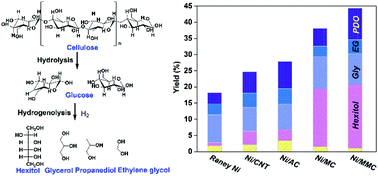当前位置:
X-MOL 学术
›
Green Chem.
›
论文详情
Our official English website, www.x-mol.net, welcomes your
feedback! (Note: you will need to create a separate account there.)
Macroporous–mesoporous carbon supported Ni catalysts for the conversion of cellulose to polyols
Green Chemistry ( IF 9.3 ) Pub Date : 2018-07-09 , DOI: 10.1039/c8gc01624k Bin Zhang 1, 2, 3, 4, 5 , Bin Chen 2, 3, 4, 5, 6 , Mark Douthwaite 7, 8, 9, 10, 11 , Qiang Liu 1, 2, 3, 4, 5 , Chao Zhang 1, 2, 3, 4, 5 , Qifan Wu 1, 2, 3, 4, 5 , Ruhui Shi 1, 2, 3, 4, 5 , Peixuan Wu 1, 2, 3, 4, 5 , Fengyu Zhao 1, 2, 3, 4, 5 , Graham Hutchings 7, 8, 9, 10, 11
Green Chemistry ( IF 9.3 ) Pub Date : 2018-07-09 , DOI: 10.1039/c8gc01624k Bin Zhang 1, 2, 3, 4, 5 , Bin Chen 2, 3, 4, 5, 6 , Mark Douthwaite 7, 8, 9, 10, 11 , Qiang Liu 1, 2, 3, 4, 5 , Chao Zhang 1, 2, 3, 4, 5 , Qifan Wu 1, 2, 3, 4, 5 , Ruhui Shi 1, 2, 3, 4, 5 , Peixuan Wu 1, 2, 3, 4, 5 , Fengyu Zhao 1, 2, 3, 4, 5 , Graham Hutchings 7, 8, 9, 10, 11
Affiliation

|
Carbon based materials are some of the most commonly studied catalysts for the conversion of cellulose to polyols. The catalytic performance of these materials, however, is typically limited by the access of the substrate to the active sites, which is governed by the poor solubility of cellulose in aqueous solutions. In an attempt to resolve this, we presented a novel hierarchical carbon material which was synthesized by a dual-templating method. Transmission electron microscopy and porosity measurements confirmed that the resultant materials consisted of both spherical macropores and well-defined mesoporous channels. Additional characterisation of this material revealed that it has an exceptionally high surface area (>1110 m2 g−1) and a high concentration of acidic sites, which are considered to be crucial for the hydrolysis of cellulose. Ni nanoparticles were subsequently immobilised onto this material and some additional carbon supports. It was determined that the high surface area and porosity of the synthesised carbon material assisted with the dispersion of the Ni nanoparticles. This Ni catalyst was found to be highly efficient for the one-pot conversion of cellulose to polyols, which is proposed to be a consequence of both the high number of acid sites and excellent Ni dispersion. This approach to catalyst design, offers a novel method for the valorisation of cellulose.
中文翻译:

大孔-中孔碳负载的镍催化剂,用于将纤维素转化为多元醇
碳基材料是将纤维素转化为多元醇的一些最常研究的催化剂。但是,这些材料的催化性能通常受底物接近活性位的限制,这取决于纤维素在水溶液中的不良溶解性。为了解决这个问题,我们提出了一种新颖的分层碳材料,该材料是通过双模板方法合成的。透射电子显微镜和孔隙率测量证实,所得材料由球形大孔和定义明确的中孔通道组成。该材料的其他特征表明,它具有异常高的表面积(> 1110 m 2 g -1)和高浓度的酸性位点,这对于纤维素的水解至关重要。随后将镍纳米颗粒固定在该材料和一些其他碳载体上。已确定合成的碳材料的高表面积和孔隙率有助于Ni纳米颗粒的分散。发现该Ni催化剂对于纤维素一锅转化为多元醇是高效的,这被认为是由于大量的酸位和优异的Ni分散性的结果。这种催化剂设计方法为纤维素的增值提供了一种新颖的方法。
更新日期:2018-07-30
中文翻译:

大孔-中孔碳负载的镍催化剂,用于将纤维素转化为多元醇
碳基材料是将纤维素转化为多元醇的一些最常研究的催化剂。但是,这些材料的催化性能通常受底物接近活性位的限制,这取决于纤维素在水溶液中的不良溶解性。为了解决这个问题,我们提出了一种新颖的分层碳材料,该材料是通过双模板方法合成的。透射电子显微镜和孔隙率测量证实,所得材料由球形大孔和定义明确的中孔通道组成。该材料的其他特征表明,它具有异常高的表面积(> 1110 m 2 g -1)和高浓度的酸性位点,这对于纤维素的水解至关重要。随后将镍纳米颗粒固定在该材料和一些其他碳载体上。已确定合成的碳材料的高表面积和孔隙率有助于Ni纳米颗粒的分散。发现该Ni催化剂对于纤维素一锅转化为多元醇是高效的,这被认为是由于大量的酸位和优异的Ni分散性的结果。这种催化剂设计方法为纤维素的增值提供了一种新颖的方法。











































 京公网安备 11010802027423号
京公网安备 11010802027423号